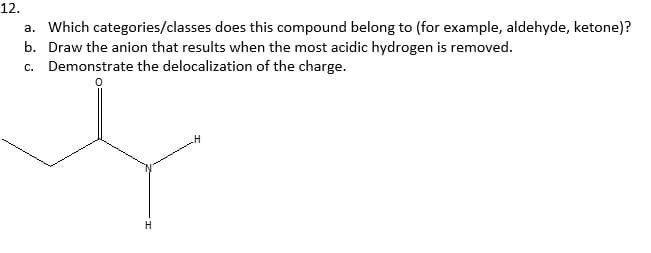a. Which categories/classes does this compound belong to (for example, aldehyde, ketone)? b. Draw the anion that results when the most acidic hydrogen is removed. c. Demonstrate the delocalization of the charge.
a. Which categories/classes does this compound belong to (for example, aldehyde, ketone)? b. Draw the anion that results when the most acidic hydrogen is removed. c. Demonstrate the delocalization of the charge.
Organic Chemistry: A Guided Inquiry
2nd Edition
ISBN:9780618974122
Author:Andrei Straumanis
Publisher:Andrei Straumanis
ChapterNW4: Nomenclature Worksheet 4: Carbonyl Compounds
Section: Chapter Questions
Problem 1CTQ
Related questions
Question
Please help with this problem!

Transcribed Image Text:12.
a. Which categories/classes does this compound belong to (for example, aldehyde, ketone)?
b. Draw the anion that results when the most acidic hydrogen is removed.
c. Demonstrate the delocalization of the charge.
H
Expert Solution
Step 1
Answer 12:
a) The given molecule to class of Amides. Because it consists of amide group i.e. -CONH2.
Step by step
Solved in 2 steps with 1 images

Knowledge Booster
Learn more about
Need a deep-dive on the concept behind this application? Look no further. Learn more about this topic, chemistry and related others by exploring similar questions and additional content below.Recommended textbooks for you

Organic Chemistry: A Guided Inquiry
Chemistry
ISBN:
9780618974122
Author:
Andrei Straumanis
Publisher:
Cengage Learning


Organic Chemistry: A Guided Inquiry
Chemistry
ISBN:
9780618974122
Author:
Andrei Straumanis
Publisher:
Cengage Learning
